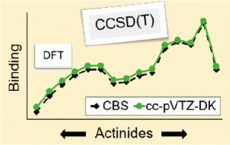Binding Preferences Predictions Across the Actinide Series

Predictive capabilities for binding preferences of lanthanides is heavily restricted by computational cost. A model lanthanide nitrate system was utilized to develop computational costreducing methods across the lanthanide series to be applied to optimization of separations in processes relevant to critical materials and nuclear forensics. Image: PenchoffDeborah, Institute for Nuclear Security Peterson et. al., ACS Omega 2019, 4, 13751385. DOI: 10.1021/acsomega.8b02403 Copyright © 2019 American Chemical Society
Science Achievement
Researchers from the Institute for Nuclear Security and Radiochemistry Center of Excellence at the University of Tennessee, University of North Texas, U.S. Army Nuclear and Countering Weapons of Mass Destruction Agency, Stony Brook University, Brookhaven National Laboratory, and Y-12 National Security Complex evaluated method dependence in binding preferences across the actinide series. NERSC supercomputers allowed for accurate targets to be established – essential to evaluate less expensive methods to be applied in binding of elements of interest in nuclear security and fundamental research of lesser-known actinide compounds.
Impact
Fundamental understanding of actinide-containing compounds is essential for nuclear security. Traditional experimental evaluation of many actinide-containing compounds is restricted to expert facilities due to the high radioactivity of these elements. Short half-lives also limit experimental capability of later actinides which still require in-depth understanding of their properties.
Research Details
These researchers developed a systematic in-depth study to evaluate commonly used methods including high levels of theory and relativistic effects seeking to establish efficient practices to be applied to actinide studies across disciplines.
Related Links
Penchoff et. al., ACS Omega 2018, 3, 14127-14143. DOI: 10.1021/acsomega.8b01800 Copyright © 2018 American Chemical Society
About NERSC and Berkeley Lab
The National Energy Research Scientific Computing Center (NERSC) is a U.S. Department of Energy Office of Science User Facility that serves as the primary high performance computing center for scientific research sponsored by the Office of Science. Located at Lawrence Berkeley National Laboratory, NERSC serves almost 10,000 scientists at national laboratories and universities researching a wide range of problems in climate, fusion energy, materials science, physics, chemistry, computational biology, and other disciplines. Berkeley Lab is a DOE national laboratory located in Berkeley, California. It conducts unclassified scientific research and is managed by the University of California for the U.S. Department of Energy. »Learn more about computing sciences at Berkeley Lab.







